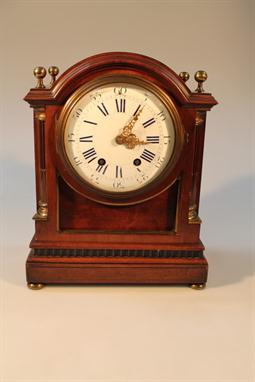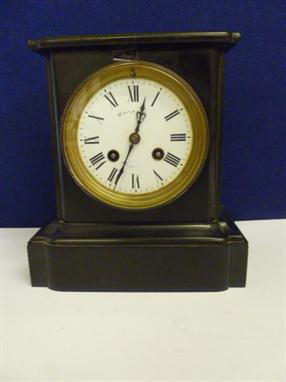We found 96232 price guide item(s) matching your search
There are 96232 lots that match your search criteria. Subscribe now to get instant access to the full price guide service.
Click here to subscribe- List
- Grid
-
96232 item(s)/page
A French patinated bronze and rouge marble mantel clock garniture, circa 1880, with eight-day bell striking movement by Samuel Marti, Paris and white enamel Arabic numeral chapter ring in a Louis XVI style lyre shaped case with pair of matching three light candelabra, the clock 69cm high. Provenance: Sotheby’s; The 19th century Interior, 11. October 2006, lot 229
An interesting mantel Clock made from the boss of an early laminated dark-wood aircraft Propeller with eight mounting bolt holes and stamped to the top ``DRG No OE8101/1, D 9`6``, P 6.40``, JAGUAR IVC, S No B5, 7 32``, mounted with a brushed finish metal clock face with Arabic numerals and later quartz movement. 14`` wide, 8 3/8`` high, 6 3/16`` deep. This originally 9`6`` diameter propeller was used on an Armstrong Siddeley Jaguar IV C engine. (The Jaguar engine was an air cooled 14 cylinder radial aero engine having two banks of seven cylinders, the then new design of engine was first run on the 21st June 1922 and developed 300 hp. The mark IV C was a modified version of the engine developed in 1928, it by that time had been increased in cubic capacity by an increase of the bores to 5 1/2 inches and displaced 24.8 litres, developed 400 hp and consumed around 20 gallons of fuel per hour. In spite of having a reputation for vibrational harshness attributed to the absence of a crankshaft main bearing between the two banks of cylinders, it was, it seems, fitted to 43 different types of aircraft and it was produced in various versions, the last development being the supercharged Jaguar VIII A of 1929. A Flight magazine article of April 8th 1926 fascinatingly refers to an epic flight by Mr. (later Sir) Alan Cobham from London to Cape town and back to London of some 17,000 miles in a de Haviland 50 bi-plane aircraft G-EBFO powered by one of these engines. After dismantling for inspection, the engine proved to be in virtually new condition with infinitesimally small amounts of wear in spite of having travelled through highly inhospitable conditions and large variations in climate.)
A 19th Century carved oak cased mantel clock in the Gothic Revival style, the stepped architectural case with dentil cornice over an arched glazed door flanked by turned, block and stop fluted pilasters with two panelled doors to each side, on a skirted base with bun feet, the arched brass dial with silvered chapter ring and slow / fast dial to the arch within gilt metal applied scrolling spandrels to a three quarter striking eight day movement on four gongs, the back plate inscribed "W & H Sch" (ILLUSTRATED)
A fine mid 19th Century four-glass carriage type mantel clock , quatre-repeating, by Payne and Co, the case with swan neck carrying handle, arch top panels to the sides, shield shaped glass panel to the front and rectangular panel to the door, the engraved gilt brass case with turned columns to the sides, fitted an engraved steel dial with gothic arch and other decoration, signed Payne and Co, 163 New Bond Street London No 3069, fitted a twin fusee movement quarter-chiming on two gongs and striking the hour on one, the back plate engraved Payne and Co, 163 New Bond Street, London No 3069, 24cm (9.5”) high
-
96232 item(s)/page










































